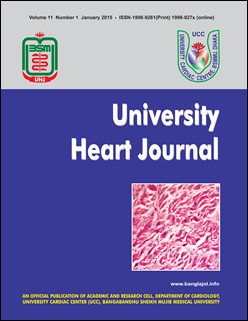Coronary Procedures by Left vs. Right Transradial Approach in Bangladeshi Diabetic Population
DOI:
https://doi.org/10.3329/uhj.v11i1.27596Keywords:
Percutaneous coronary procedure, Transradial approachAbstract
Background: Radial arterial approach is the usual option for coronary procedures in our hospital. Our aim was to evaluate the safety and efficacy of left radial approach (LRA) compared with right radial approach (RRA) for coronary procedures.
Methods: This study is a single centre, single operator randomized study. Only diabetic patients more than 18 years old with bilateral normal allens test requiring coronary procedures (CAG and PCI) were included in this study. Study period was since January, 2011 to February, 2012. Primary PCI were excluded from this study. The patients were randomized to LRA or RRA arm for coronary procedures. Primary endpoint for diagnostic CAG was contrast volume and fluroscopy time and secondary endpoint was the prevalence of high grade subclavian tortuosity and number of diagnostic catheters used. Size of the conventional guide catheter (5 or 6 F) was compared in both arms irrespective of left or right coronary PCI.
Results: Total 512 diabetic patients were enrolled for CAG and equally divided into LRA (256 patients) or RRA (256 patients) arms. Total 290 PCI was performed (145 LRA and 145 RRA). In CAG, LRA arm showed significantly lower fluroscopy time (p = 0.006) and contrast volume (p= 0.005) though more use of double diagnostic catheter (5 F TIG and JR) was present in LRA group. In PCI, RRA arm needed signicantly more 5 F guide catheter (p=0.001). Subclavian tortuosity were more observed in female RRA group.
Conclusions: In diabetic population, CAG by left radial approach was superior to right in terms of amount of contrast and fluroscopy time. Subclavian tortuousity was more observed in right and especially more in female. In PCI, 6 F conventional guide catheters were commonly used in both approache though 5 F guide catheter were used more in right radial approach due to extreme subclavian tortuousity and diffuse disease. Dedicated sheathless guide catheter may resolve this issue.
University Heart Journal Vol. 11, No. 1, January 2015; 26-29
Downloads
1033
202

